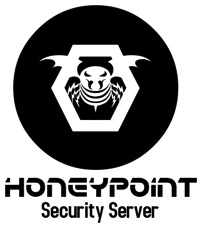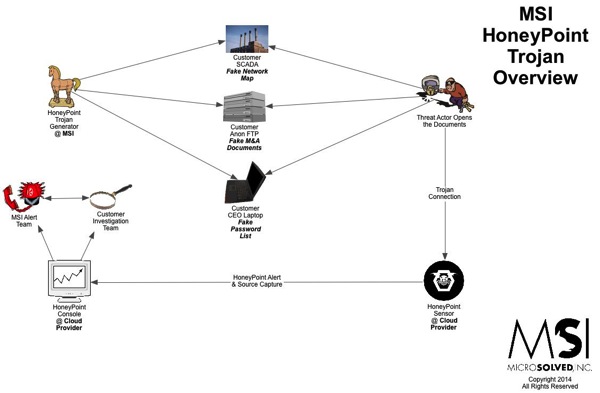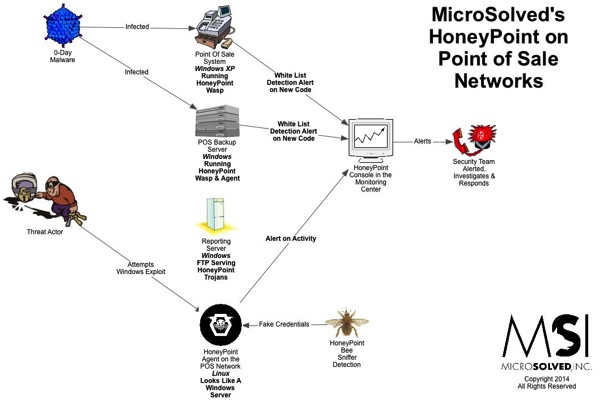
Spike in HITME NTP Probes Following Recent Exploits



Prior to joining MicroSolved as an Intelligence Engineer, I was the Information Security Officer and Infrastructure Manager for a medical management company. My company provided medical care and disease management services to over 2 million individuals. Throughout my tenure at the medical management organization, I kept a piece of paper on my bulletin board that said “$100,000,000”.
Why “$100,000,000”? At the time, several studies demonstrated that the average “street value” of a stolen medical identity was $50. If each record was worth $50, that meant I was responsible for protecting $100,000,000 worth of information from attackers. Clearly, this wasn’t a task I could accomplish alone.
Enter: MicroSolved & HoneyPoint
Through my membership with the Central Ohio Information Systems Security Association, I met several members of the MicroSolved team. I engaged them to see if they could help me protect my organization from the aforementioned attackers. They guided me through HIPPA/HITECH laws and helped me gain a further understanding of how I could protect our customers. We worked together to come up with innovative solutions that helped my team mitigate a lot of the risks associated with handling/processing 2 million health care records.
A core part of our solution was to leverage the use of HoneyPoint Security Server. By using HoneyPoint, I was able to quickly gain visibility into areas of our network that I was often logically and physically separated from. I couldn’t possibly defend our company against every 0-day attack. However, with HoneyPoint, I knew I could quickly identify any attackers that had penetrated our network.
Working for a SMB, I wore many hats. This meant that I didn’t have time to manage another appliance that required signature updates. I quickly found out that HoneyPoint didn’t require much upkeep at all. A majority of my administrative tasks surrounding HoneyPoint were completed when I deployed agents throughout our LAN segments that mimicked existing applications and services. I quickly gained the real-time threat analysis that I was looking for.
If you need any assistance securing your environment or if you have any questions about HoneyPoint Security Server, feel free to contact us by sending an email to: info@microsolved.com.
This post contributed by Adam Luck.
For those of you that are unfamiliar with the HITME project, it is a set of deployed HoneyPoints that gather real-world, real-time attacker data from around the world. The sensors gather attack sources, frequency, targeting information, vulnerability patterns, exploits, malware and other crucial event data for the technical team at MSI to analyze. We frequently feed these attack signatures into our vulnerability management service to ensure that our customers are tested against the most current forms of attacks being used on the Internet.
It’s also important that we take a step back and look at our HITME data from a bird’s-eye view to find common attack patterns. This allows us to give our customers a preemptive warning in the event that we identify a significant increase in a specific threat activity. We recently analyzed some of the data that we collected during the month of November. We found that over 47% of the observed attacks in the public data set were against the Remote Desktop Protocol (RDP)(often also known as Microsoft Terminal Services). This was more than attacks against web servers, telnet servers and FTP servers combined!
Be sure that all recommended security measures are applied to RDP systems. This should include requiring the use of RDP clients that leverage high levels of encryption. If you need any assistance verifying that you are protected against attacks against your terminal servers, feel free to contact us by sending an email to info(at)microsolved(dot)com.
This post by Adam Luck.
We are thrilled to announce the immediate availability for a new position at MSI. Yes, if you have what it takes, you can join our team! We are seeking a very talented, motivated individual who can come aboard and help us with tasks related to HoneyPoint and TigerTrax. The new position is detailed below. The successful candidate will be local to the Central Ohio area (must be able to be work from the Columbus HQ) and will be motivated, engaging and capable of self-directed work. Primarily, the position will be focused on helping clients with scoping and installation of HoneyPoint and performing TigerTrax engagements.
Future career options for the position would be a choice between pursuing a future position on the technical security team (including pen-testing, etc.) or to grow into the deeper intelligence/research team that currently is embodied by TigerTrax. While the initial position will expose you to both, together, we can help scope where your interests and talents lie. Management and team leadership are also possible in either career path, as well.
This is a full time salary position, with benefits and a wide range of flexible working arrangements once the proper skills and trust are built. It also includes profit sharing, 401K with match and a variety of other benefit packages.
Successful candidates will present a resume, cover letter and a sample of their professional writing. You can apply for the position by emailing these items (PDF format) to info <at> microsolved <dot> com. No calls or placement/recruiters, please.
Further details of the position:
The information technology analyst is a key member of the MicroSolved, Inc. team who specializes in our software and research tool set. This team member must be:
The successful analyst should be detail oriented, enjoy reading, solving logic and language puzzles and be proficient with technical writing and technical reports. Occasional travel, including internationally, is required.
This team member is responsible for research projects beginning with data generation through report preparation and delivery to the client. This team member is also responsible for the scoping and deployment of MicroSolved, Inc’s threat detection platform – HoneyPoint Security Server (HPSS).
As always, thanks for reading, and I hope to see you on the team very soon!
One of the clients we were working with recently wanted me to share their thoughts on deploying HoneyPoint Security Server with the blog audience.
His company recently installed the HoneyPoint Security Server suite into their network. Their management teams were a little nervous, at first, that offering a honeypot to attackers might attract bad people to their networks. But, when the security team explained that these were going to be simply deployed on the INTERNAL networks and not visible from the Internet, so someone would already have to be inside the network to see them, they gained approval. The security team explained that they planned to use HoneyPoint as a supplement to their existing perimeter network IDS, and their log monitoring tools.
The security team convinced their immediate manager of the HoneyPoint product by describing it as a “No Lose” product to deploy. If they dropped in the HoneyPoint Agents and captured bad actors or malware moving in the network, they would win by identifying existing compromises. If they dropped in HoneyPoint and never got a hit at all, they would win, and could tell the management that even upon closer examination with the new detection tools, the network seemed to be clean of malware and overt attacker activity. This, in combination with the other forms of detection and reporting they were doing would further strengthen their position with management that the security team was remaining vigilant.
In the end, the team observed a few pieces of malware within the first 90 days and quickly eliminated the infections. They then began to plan on deploying HoneyPoint Agent into a malware black hole, in coordination with their internal DNS team. As of this writing, the deployment in the new position should go live within 30 days. In most cases, teams using HoneyPoint in this fashion quickly identify other more deeply hidden malware. The security team looks forward to leveraging the data from the HoneyPoint black hole to clean the environment more aggressively.
So, there you have it. Another client strikes a win with HoneyPoint. You can learn more about this “No Lose” product by getting in touch with your MSI account executive. You can also find more information by clicking here.
We are proud to announce the immediate availability of HoneyPoint Security Server training videos. You can now learn more about installing and using the Console, Agents, the HPSS Proxy and soon Wasp, HoneyBees and Trojans.
Jim Klun (@pophop) put the videos together and will continue to build the series over the coming months. Check them out and give Jim some feedback over Twitter. Also, let us know what other videos you would like to see.
You can get access to the videos using the credentials provided to you with your HoneyPoint license. The videos, along with a brand new User Guide, are now available from the distro web site.
Thanks to all HPSS users, and we promise to continue to evolve HPSS and make it even easier and more powerful over the coming year. As always, thanks for choosing MSI as your security partner. We appreciate it and greatly value your input!

MSI is proud to announce the immediate availability of the HoneyPoint Console version 4.0!
The new version of the Console for HPSS is now available for Windows, Linux and Mac OS X. In addition to the Console, new installer tools and documentation is also available.
The new Console finally includes operation as a service/daemon WITHOUT the need to have the GUI running. That’s right, finally headless consoles that work immediately with SEIM and other monitoring tools. Configuration of the Console and management is still available through the GUI, but headless operation is now at the core of the Console product line!
Other improvements include bug fixes, increased error handling, better memory management, improved installers and installation tools and much much more. If you haven’t upgraded your Console or seen the new 4.0 Console yet, we think you will find it much improved.
To obtain the new Console, refer to your QuickStart Guide. It is now available through the HoneyPoint distribution site. No changes to the database or license key are required, however, you must have a current license to qualify for the upgrade. Please back up your Console databases prior to upgrading, though we have experienced no issues with the upgrade process.
Thanks, as always, for choosing HoneyPoint Security Server and MSI. We value your partnership and trust.
Here’s another use case scenario for HoneyPoint Security Server. This time, we show the methodology we use to scope a HoneyPoint implementation around protecting a specific set of Intellectual Property (IP).
If you would like an in-depth discussion of our process or our capability, please feel free to reach out to us and schedule a call with our team. No commitment and no hard sale, guaranteed.
If the graphic below is blurry on your device, you can download a PDF version here.
Here’s another quick overview graphic of how HoneyPoint Trojans work. We have been using these techniques since around 2008 and they are very powerful.
We have incorporated them into phishing exercises, piracy studies, incident response, intrusion detection, intelligence gathering, marketing analysis and even privacy research. To hear more about HoneyPoint Trojans, give us a call.
If the graphic below is blurry on your device, you can download a PDF version here.

We have been getting a LOT of questions lately about how HoneyPoint Security Server (HPSS) fits into a Point of Sale (POS) network.
To make it pretty easy and as a high level overview, below is a use case diagram we use to discuss the solution. If you would like a walkthrough of our technology, or to discuss how it might fit into your specific use cases, please let us know.
As always, thanks for reading and for partnering with MicroSolved, Inc.
PS – If the graphic below is difficult to read on your device, you can grab a PDF version here.
